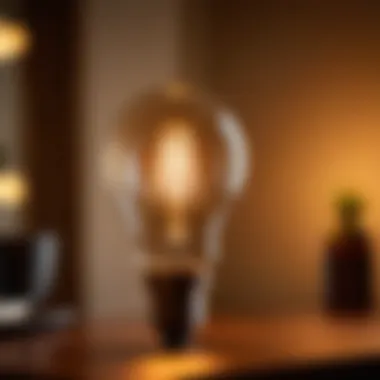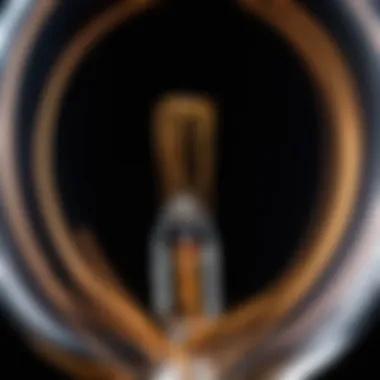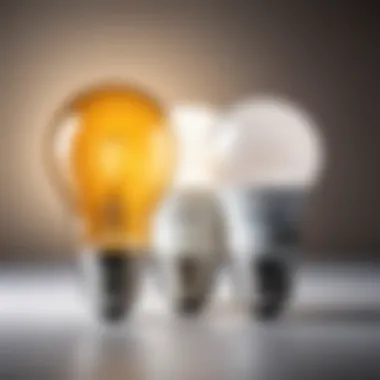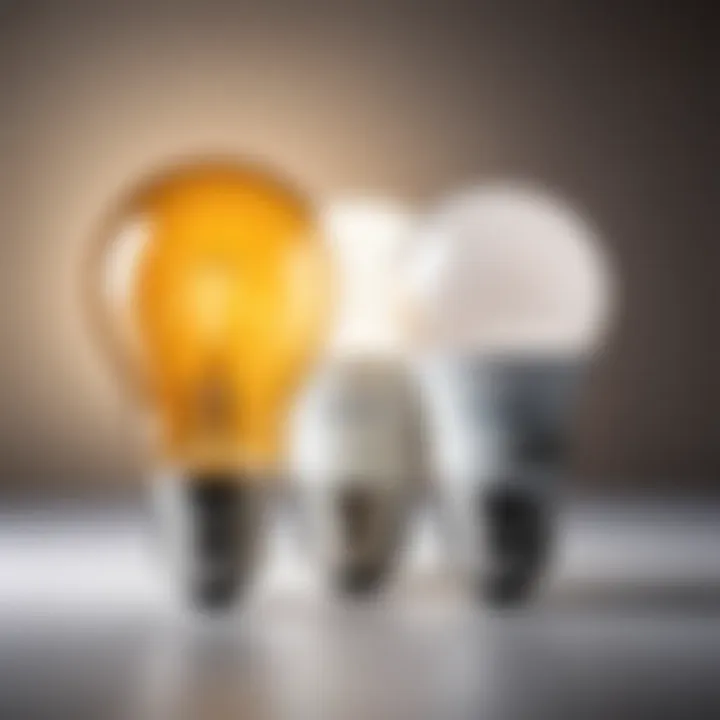Philips Incandescent Bulbs: Design and Impact Analysis


Актуальные акции и скидки
When it comes to purchasing Philips incandescent bulbs, knowing where to find the best deals is of utmost importance. These lights have stood the test of time for their warm glow and reliable brightness, but they can also be a bit of a strain on the wallet if not bought wisely.
Обзор текущих предложений
Right now, several retailers have seasonal promotions on Philips bulbs. Websites like Amazon and Home Depot often offer discounts, particularly during back-to-school season and holidays. If you’re a savvy shopper, it pays to keep an eye out for their discounts:
- Amazon: Frequently runs flash sales for Philips incandescent bulbs with discounts up to 30% off.
- Home Depot: Cheaper options can sometimes be found during their inventory clearance sales, especially on older stock of incandescent types.
- Walmart: Worth checking as they often match online prices and sometimes have unadvertised specials in-store.
Специальные предложения от популярных брендов
Certain brands and retailers even bundle deals together, which can maximize savings:
- Philips sometimes places their products in combination packs.
- Target often has a ‘buy two, get one free’ offer on select household items, including lighting solutions like incandescent bulbs.
- Costco: For those with a membership, buying in bulk can save quite a bit if you plan to stock up.
Рекомендуемые товары
Philips offers an array of incandescent bulbs that cater to different needs and preferences. Here are some recommendations based on energy efficiency and user ratings:
Топ товаров со скидками
- Philips 60-Watt A19: Well-loved for its classic shape and smooth light output, often available at great prices.
- Philips 100-Watt A19: Bright and powerful, perfect for areas needing a lot of illumination; check for bulk pricing.
- Philips Soft White: For a cozy ambiance, this one remains a customer favorite and can regularly be found on sale at major retailers.
Товары, которые стоит купить по сниженной цене
- Philips Halogen Bulbs: A more energy-efficient twist on the traditional incandescent bulb; these can frequently be found at reduced rates.
- Philips Decorative Bulbs: Stylish options for fixtures, ideal for enhancing the aesthetic without breaking the bank, often on sale at home décor stores.
Philips incandescent bulbs have become almost nostalgic symbols of a warm glow in living spaces, but with today's energy concerns, balancing cost and comfort is vital.
While these bulbs may not be the frontrunners in energy efficiency, they do provide unique benefits. Keep an eye on the current trends and regulations affecting lighting choices, as they could impact future purchases as well. Staying informed can guarantee making the most out of your illumination needs while also saving some dollars.
Prolusion to Philips Incandescent Bulbs
Philips Incandescent bulbs have been a classic choice in the landscape of home lighting for generations. They offer a warm, familiar glow that many still prefer and use today. Although technology has evolved, the enduring popularity of these bulbs cannot be dismissed easily. Understanding their role in lighting not only highlights their practical advantages but also the nostalgic value they hold for many families.
Historical Context
At the heart of the discussion on Philips Incandescent bulbs lies a rich history that dates back well over a century. Thomas Edison may have popularized the incandescent light bulb, but it was companies like Philips that propelled advancements in the production and functionality of these essential household items.
Founded in 1891 in the Netherlands, Philips has consistently been at the forefront of innovation in electrical engineering. Early on, they focused on improving the quality of light and the longevity of bulbs. Innovations such as the introduction of the coiled filament and improved glass production techniques led to more efficient and durable options for consumers. This not only served the burgeoning demand for household lighting but also laid the groundwork for the company’s current reputation for quality.
As societal needs shifted with the introduction of electricity, the incandescent bulb became a staple in homes, shaping not just illumination but also the ambiance and emotional settings within living spaces. People often chose these bulbs for their softer quality of light, unlike harsher alternatives, leading to an emotional attachment to the warmth they produce. The incandescent format has thus carved out a unique niche in home lighting, capturing the hearts of many.
The Role of Incandescent Bulbs in Home Lighting
The role of these bulbs in home lighting extends beyond mere functionality. They create an environment that feels cozy and inviting; this effect is crucial, especially in family settings where children feel secure under a warm light. Incandescent bulbs, often seen as the "good ol' days" lights, provide a comforting halo that newer technologies sometimes struggle to replicate.
- Light Quality: One of the key factors that differentiate incandescent bulbs from their LED counterparts is their light quality. The color rendering index (CRI) of incandescent bulbs is generally high, making colors appear vibrant and true to life.
- Dimming Capability: They play nicely with dimmer switches, allowing users to effortlessly adjust the brightness according to their needs. This characteristic is particularly appealing for family gatherings or quiet evenings at home.
- Familiarity and Preference: Many consumers prefer the distinct warmth of incandescent light, which can create better atmosphere in rooms designed for relaxation and family time. The nostalgia of using these bulbs often outweighs the temptations of newer technologies.
Design Features of Philips Incandescent Bulbs
The design of Philips incandescent bulbs is not merely about aesthetics or having a pretty light fixture; it extends deeply into aspects like functionality, energy efficiency, and consumer satisfaction. Understanding these design features can help users make informed decisions. Given the shift towards more energy-efficient lighting solutions, the significance of these bulbs remains critical, especially in homes where warm, quality light is desired.
Materials and Construction
Philips incandescent bulbs are constructed with a thoughtful selection of materials designed to ensure durability and performance. The glass envelope is often made from clear or frosted glass, serving a dual purpose: it protects the filament and helps diffuse light. The filament itself, usually made from tungsten, is known for its high melting point and excellent conductivity. This ensures a bright glow while maintaining a reasonable lifespan.
"The materials used in the construction of these bulbs significantly influence their efficiency and illumination quality."
Moreover, these bulbs often feature a brass base, which improves connectivity and ensures the bulb screws securely into fixtures. Certain models might even include features like a shatter-resistant coating, making them safer, particularly in households with children. Additionally, some designs embrace an eco-friendlier approach, although, by design, incandescent bulbs remain less efficient compared to their newer counterparts.
The various designs available also cater to different applications—from standard A-shaped bulbs to more exotic styles like vintage globe-shaped bulbs. Each option serves a specific function in terms of ambience and aesthetic appeal in home lighting.
Varieties and Specifications
Diving deeper, there’s a rich variety in Philips incandescent options. Consumers can choose from varying wattages that affect not only brightness but also the warmth of the light produced. Typically, these bulbs range from around 40 watts, providing softer light, to 100 watts, suitable for illuminating larger spaces.
Furthermore, Philips offers dimmable options, allowing users to control the ambiance easily, which can be particularly valuable in areas meant for relaxation, such as living rooms or bedrooms.
In terms of specifications, these bulbs generally have a color temperature of about 2700K, giving off a warm, inviting glow that many find preferable over the cooler tones of fluorescent or LED lights.
When considering longevity, it’s important to note that traditional incandescent bulbs tend to last around 1,000 hours. While this is less than energy-efficient alternatives, their warm light and color rendering capabilities often make them the go-to choice for various settings.
To summarize, when looking at the design features of Philips incandescent bulbs, it becomes clear that their materials and construction specifics along with the varieties available contribute to their lasting appeal. Whether it's about choosing the right wattage or deciding on the suitable style, each element is crafted with the user in mind, balancing aesthetics and functionality.
Functionality of Philips Incandescent Bulbs
When discussing Philips incandescent bulbs, it is essential to delve into their functionality. This segment explores how these bulbs perform certain roles in lighting, the benefits they provide to consumers, and crucial considerations related to their use. Understanding functionality encompasses both the technical aspects of illumination and the practical advantages Philips bulbs offer, informing consumers about their overall value.
Illumination Quality
The illumination quality delivered by Philips incandescent bulbs stands out as a notable feature. These bulbs emit a warm white light that many find inviting and comforting. Unlike some modern lighting options that can come off as cold or harsh, the light produced by incandescent bulbs tends to create a homely atmosphere. This quality is particularly appealing in living spaces, where aesthetics play a crucial role in how the environment feels.
Moreover, the color rendering index (CRI) of incandescent bulbs is typically closer to natural daylight, making colors appear vibrant and true to life. This has significant value in settings where color accuracy is essential, such as art studios or retail environments.
"Incandescent bulbs offer a calming glow, which adds a touch of familiarity to our homes."


Interestingly, while newer LED technologies provide energy efficiencies, many consumers still appreciate the softer light that incandescent provides. It’s about creating an ambience that makes one feel at ease—a factor that should not be understated in a bustling world.
Longevity and Efficiency
Turning to longevity and efficiency, this subject requires a nuanced understanding. It’s well known that incandescent bulbs don’t outlast many of their contemporary counterparts, like LEDs or compact fluorescents. Typically, a Philips incandescent bulb boasts a life span ranging from 750 to 2,000 hours. This is significantly lower than what some LEDs offer, which can exceed 25,000 hours.
Despite their shorter lifespan, the initial cost of Philips incandescent bulbs remains relatively low, making them accessible for various consumers. This lower purchase price is a selling point, especially for those who may not be ready to fully shift to more permanent solutions like LEDs. In terms of energy efficiency, incandescent bulbs use about 60-100 watts, which is substantially more compared to the estimated 10-20 watts for equivalent LED bulbs. This is where a cost-benefit analysis can come into play. When it comes to purchasing bulbs, consumers weighing upfront costs against down-the-road savings will find they need to think critically.
Additional considerations include potential changes in user behavior due to lighting needs. Philips incandescent bulbs provide that consistent level of brightness and warmth, which can sometimes outweigh the savings on electricity for consumers who prioritize comfort and aesthetics over efficiency.
Market Position of Philips Incandescent Bulbs
Understanding the market position of Philips incandescent bulbs is crucial for grasping their significance within the lighting industry. Various elements come into play here, including the brand's reputation, consumer preferences, and regulatory aspects. Philips has carved out a niche by consistently offering quality products that merge reliability with consumer loyalty. In an age where energy efficiency takes precedence, understanding where Philips stands can help individuals and businesses make informed decisions about their lighting choices.
Comparison to Competitors
When one looks at the landscape of incandescent lighting, it’s worthwhile to compare Philips with its main competitors, such as GE and Sylvania. Each brand has its own unique selling points, but Philips is often recognized for its superior durability and light quality.
- Quality of Light: Philips incandescent bulbs typically offer a warmer glow, which many consumers associate with comfort and homeliness. This characteristic can be crucial when choosing bulbs for living spaces, as ambiance plays a key role in how we feel in our homes.
- Longevity: Compared to competitors, Philips bulbs tend to last longer, even among incandescent options, which makes them a more economical choice over time.
- Variety: Philips presents a diverse range of bulbs, catering to various lighting preferences and fixtures—everything from standard bulb shapes to specialty designs for pendants and chandeliers.
In contrast, other brands may not offer such a comprehensive array of options, which can limit consumers’ choices.
Consumer Preferences and Trends
Consumer preferences in the lighting market are ever-evolving. As awareness around sustainability grows, so does the inquiry into the role of classic incandescent bulbs within this framework. Interestingly, while many consumers are shifting to LED technologies for efficiency, there remains a substantial market for incandescent bulbs, particularly for decorative applications or specific atmospheres.
- Style Over Function: For some homeowners, the aesthetic appeal of incandescent light often outweighs the benefits of energy efficiency. Philips bulbs, with their more traditional shapes and warm tones, cater to this segment.
- Nostalgia: There's a certain nostalgia tied to incandescent lighting. Many people have fond memories associated with the warm glow, making them reluctant to switch to colder, harsher LED lights.
- Practical Needs: On a practical level, consumers often seek bulbs that are easy to install and compatible with various lamp fixtures, which Philips excels at providing.
Additionally, trends reveal that consumers are becoming more gadget-savvy, making them more inclined to adjust their lighting solutions according to specific requirements. With innovations in smart lighting technology that can incorporate incandescent bulbs, such as Philips' own offerings, the market sees an intriguing blend of tradition and modernity.
"Understanding the dynamics of the market is the foundation for making well-informed decisions about lighting solutions."
Regulatory Influences and Sustainability Considerations
Discussing regulatory influences and sustainability is crucial, especially in today’s world where energy conservation and environmental impact weigh heavily on consumers’ minds. As lighting technology evolves, regulations tend to follow suit, shaping how companies like Philips approach the manufacture and distribution of incandescent bulbs. Understanding the framework of these regulations helps consumers make informed decisions regarding their lighting choices.
Impact of Energy Efficiency Regulations
Energy efficiency regulations set the stage for how light bulbs are produced and marketed. Various governments have rolled out standards aimed at reducing energy consumption across the board. For incandescent bulbs, this means that manufacturers must comply with stricter efficiency ratings that dictate how much energy a bulb consumes in relation to the light it emits.
- Mandatory Standards: Many regions now enforce a minimum level of efficiency, often pushing consumers towards more energy-efficient options.
- Incentives for Energy Savings: Some governments offer rebates or tax breaks for using energy-efficient bulbs, indirectly affecting sales of incandescent varieties.
- Market Shift: As brands strive to meet these regulations, there’s a noticeable shift in the market, steering consumers towards compact fluorescent lamps (CFLs) and light-emitting diodes (LEDs).
Nevertheless, Philips has managed to retain a strong position in a changing regulatory landscape. The company has invested in innovations that help their incandescent bulbs comply with current standards while still delivering the warmth and quality of light many consumers prefer.
Sustainability Practices at Philips
Philips doesn’t just see regulations as an obstacle; they view them as a catalyst for change and improvement. The company has taken significant steps towards aligning with sustainable practices in light bulb production. This not only ensures compliance but also addresses growing environmental concerns among customers.
- Use of Recyclable Materials: Philips aims to reduce its carbon footprint by incorporating materials that can easily be recycled. This takes a load off landfills and promotes a more circular economy.
- Reducing Waste: Continuous efforts are made to minimize manufacturing waste, an essential element in production sustainability.
- Renewable Energy Initiatives: Philips has committed to sourcing renewable energy for their factories, further reducing the environmental impact of their operations.
"Every little bit counts towards sustainability. Philips aims to lead by example in promoting eco-friendly practices in lighting technology."
Product choices should reflect a consumer's values regarding sustainability and energy efficiency. While incandescent bulbs, especially from Philips, offer certain emotional and aesthetic qualities, it remains essential to weigh these benefits against regulatory requirements and sustainability practices.
By keeping an eye on these influences, consumers can make smarter lighting decisions that resonate with their values and their pockets.
Consumer Considerations Before Purchase
When it comes to purchasing Philips incandescent bulbs, understanding consumer considerations is key to making an informed choice. Many factors can influence which bulb to select, from lumens and wattage to the overall purpose of your lighting. Knowing your lighting needs and balancing costs with benefits can have a significant impact on your satisfaction with the final decision.
Assessment of Lighting Needs
Before you even think about making a purchase, take a moment to identify your specific lighting needs. Different situations require different lighting solutions. For instance, if you’re searching for a cozy atmosphere in a living room, a soft white bulb might serve you better than a bright daylight option. Phillips offers a range of tonal qualities, meaning you can choose between warm white for that inviting vibe or bright daylight for tasks needing focus.
A few factors to consider include:
- Room Size: Larger spaces may benefit from higher-wattage bulbs, while smaller rooms can thrive with lower wattage.
- Mood and Function: Are you aiming for ambiance or functionality? Mixing options across your home might create a more harmonious environment.
- Dimmability: If you're keen on adjusting brightness, look for bulbs that can be dimmed appropriately. Not every bulb fits the bill, so checking compatibility is essential.
Taking your time to assess these elements enhances your chances of getting the right bulb that meets your practical and aesthetic goals.
Cost-Benefit Analysis
engaging in a cost-benefit analysis serves as the backbone of any sensible purchasing decision. In comparing Philips incandescent bulbs to alternatives such as LEDs or CFLs, it’s important to reflect on both immediate costs and long-term savings.
- Initial Cost: Philips incandescent bulbs can be cheaper upfront compared to their LED counterparts, making them attractive for those tight on budget.
- Energy Consumption: Incandescent bulbs use more energy, leading to higher electricity bills over time. This could be a deal breaker for some folks who are keen on energy-saving practices.
- Lifespan: Philips incandescent bulbs tend to last far less time than LED or CFL alternatives. This means frequent replacements, which can spiral costs unexpectedly high in the long run.
- Lighting Quality: One can't dismiss the warm glow that incandescent offers, which remains an allure even in the age of energy efficiency. This aspect should weigh in heavily—for some people, the quality of light trumps just about everything else.
"Always consider both the price tag and what you get for it in the long run. Maximizing both satisfaction and economy is the name of the game."
Alternatives to Incandescent Bulbs
In the modern world, where energy efficiency and sustainability are high on the agenda, alternatives to incandescent bulbs have gained significant attention. Understanding these alternatives is crucial for making informed decisions, especially when it comes to balancing illumination needs with budget considerations. The landscape of lighting options has diversified, allowing consumers to choose not only based on their preferences but also based on energy requirements, which can have a long-term economic impact.
Overview of LED and CFL Options
Two of the most significant alternatives to traditional incandescent bulbs are LED (Light Emitting Diode) and CFL (Compact Fluorescent Lamp) options. Each presents distinctive features that cater to various user needs.
LED bulbs are celebrated for their longevity, often lasting up to 25,000 hours, which is 25 times longer than standard incandescent bulbs. They offer superior energy efficiency, consuming about 75% less energy. Also, LEDs emit very little heat, making them safer, especially in tighter spaces or fixtures prone to overheating. These bulbs come in various color temperatures, from warm white to daylight, allowing consumers to match their lighting to their specific ambiance requirements.
CFLs, on the other hand, have been a popular choice for energy-conscious consumers for a while. They last about 10,000 hours, offering 70% energy savings compared to traditional incandescent bulbs. However, they can take a few minutes to reach full brightness, which may not suit all lighting needs. It’s also worth noting that CFLs contain a small amount of mercury, which necessitates careful disposal to avoid environmental harm.


Both LED and CFL bulbs come in diverse shapes and sizes, making them versatile options for various fixtures around the home. It can vary from standard A-shape bulbs to decorative options, which fits the niche for aesthetic preferences.
Advantages and Disadvantages
When considering alternatives, it's vital to weigh the pros and cons.
Advantages of LED and CFL:
- Energy Efficient: Both options use significantly less energy than incandescent bulbs.
- Longevity: LEDs last longer, reducing the frequency of replacement.
- Variety: The range of styles allows for creativity in interior design.
- Thermal Management: LEDs don’t emit much heat, making them safer to use.
- Environmental Impact: Reduced energy consumption leads to lower carbon emissions.
Disadvantages of LED and CFL:
- Cost: The initial investment may be higher, particularly for LED options.
- Dimming Compatibility: Not all LED and CFL bulbs work well with dimmer switches, unlike traditional options.
- Warm-up Time: CFLs can take longer to reach their full brightness.
"Choosing the right bulb is not just about light; it reflects a lifestyle choice that impacts both pocket and planet."
As decisions are made around lighting, the ability to inform oneself about these alternatives will result in better outcomes, balancing functionality, aesthetics, and sustainability.
Culmination: The Future of Philips Incandescent Bulbs
The journey of Philips incandescent bulbs does not culminate with the current market dynamics or consumer trends we see today. Rather, it serves as a reflection of how traditional lighting is navigating the complex waters of technological advancement and shifting preferences. As we draw our narrative to a close, it's clear that understanding the future of these bulbs involves examining technological developments as well as evolving consumer expectations.
Technological Developments
Technological advancements play a pivotal role in the continued relevance of Philips incandescent bulbs. Though LEDs and CFLs have made significant inroads due to their energy efficiency, Philips isn’t sitting idle. The company is harnessing technology to improve its incandescent offerings. One of the more noteworthy innovations is the development of halogen incandescent bulbs. These bulbs merge traditional technology with improved performance, achieving higher luminosity and longer lifespan while still maintaining that warm light quality many consumers cherish.
Furthermore, the focus on smart integration cannot be overlooked. As homes become increasingly interconnected, incorporating voice-activated assistants and smart lighting solutions, Philips is also adapting incandescent designs to cater to this trend. For example, bulbs that can be controlled remotely, dimmed, or adjusted in hue through smart technology reflect an adaptable approach to what consumers expect from their lighting solutions today.
This approach not only seeks to maintain customer interest but also bridges traditional lighting with modern functionality. Just like old-school music platforms mixed it up with streaming services, Philips is marrying classic light bulbs with new tech.
Consumer Trends and Market Adaptations
In assessing the future, consumer behavior is undeniably a core factor. Shifting attitudes toward energy conservation and eco-friendliness are influencing purchasing decisions. People today often seek out options that not only light up their spaces but also align with their values. However, nostalgia plays its hand too. There is a segment of the market that favors the soft, inviting glow of incandescent bulbs, evoking a sense of warmth and comfort that some alternative technologies may lack.
As consumers lean towards both sustainable choices and emotional connections in buying, Philips is making subtle adjustments to cater to this duality.
- Educational Campaigns: It continues to roll out information campaigns stressing not only the unique aesthetic appeal of incandescent bulbs but also their practical uses within an eco-conscious framework.
- Customization Options: Offering various color temperature options further allows consumers to personalize their space while still choosing traditional technology. Consumers increasingly want to feel tailored experiences in every aspect of their lives, including lighting.
- Responsive Marketing: Additionally, Philips has seen success in social platforms where discussions about design, sustainability, and practicality intermingle. Engaging with communities on platforms like Reddit or even Facebook opens avenues for direct feedback, allowing Philips to adjust its strategies in real-time based on consumer sentiment.
In summary, as Philips navigates its path forward, the interplay between technology and consumer preferences will shape its strategy. With the right balance of tradition and modernity, the future of Philips incandescent bulbs looks not only viable but promising for a range of lighting needs.
Consumer Feedback and Experiences
Understanding consumer feedback is crucial in analyzing Philips incandescent bulbs. The experiences of users provide insightful perspectives that inform potential buyers about product performance, usability, and overall satisfaction. This section delves into how consumer feedback can shape purchasing decisions, offering a nuanced view of how these bulbs fit into modern lighting needs.
User Reviews and Ratings
Philips incandescent bulbs often receive a mixed bag of user reviews, reflecting a range of experiences from satisfaction to disappointment. On platforms like Reddit and Facebook, consumers share stories that reveal both triumphs and pitfalls.
- **Pros:
- **Cons:
- Warm Light Quality: Many users praise the bulbs for their soft, warm glow that creates a cozy atmosphere in homes.
- Simplicity of Use: The ease of installation is frequently highlighted, with users noting that they can simply screw the bulb into existing fixtures without hassle.
- Variety of Options: The availability of different wattages and styles allows consumers to choose bulbs that fit their specific needs and aesthetic preferences.***
- Shorter Lifespan: Some consumers have voiced concerns regarding the longevity of these bulbs compared to newer alternatives like LEDs, leading to frequent replacements.
- Energy Usage: With rising energy costs, a number of user reviews reflect frustrations over higher energy consumption than expected, making the costs add up over time.
- Dimming Issues: Certain users report challenges with dimmable bulbs, where they flicker or don’t work well with existing dimmer switches.
Overall ratings can often be found on popular e-commerce sites, with many ratings ranging from 3 to 4.5 stars. These ratings not only help future buyers gauge product performance but also shed light on the reliability of the Philips brand in the incandescent market.
Common Complaints and Recommendations
Like any product, Philips incandescent bulbs come with their share of complaints. Addressing these can help potential buyers set realistic expectations while making informed choices.
- Frequent Complaints:
- Recommendations From Users:
- Burnout Rate: Many users report bulbs burning out faster than anticipated. This can be particularly frustrating for those who expect a traditional incandescent bulb lifespan but find themselves repurchasing sooner than expected.
- Color Consistency: Another common concern is the color emitted by different batches of bulbs. Several users have noted variances in warmth and brightness, which can disrupt a carefully curated lighting scheme.
- Replacement Considerations: Consumers advise keeping a stock of spare bulbs as part of their home supplies, given the frequent need for replacements. This suggestion emphasizes preparedness for sudden outages.
- Mixing Options: Some users recommend mixing incandescent bulbs with LED options in the same fixtures to balance cost efficiency with the desired warmth of incandescent light.
Philosophy of Light in Modern Design
In today's world, where aesthetics are often appreciated alongside practicality, the philosophy of light plays a crucial role in modern design. When it comes to evaluating anything from incandescent bulbs to contemporary lighting solutions, understanding how light affects space and mood becomes paramount. It’s not just about brightness or visibility; it’s about how light transforms an environment and influences the feelings of those within it. Philips, as a key player in the lighting industry, recognizes these nuances and shapes its incandescent bulb design accordingly.
Aesthetic Considerations
When discussing aesthetics, we're talking about more than just a bulb's outer appearance. The design of a bulb—its shape, color temperature, and lumens—can drastically alter a room's ambiance. Think of the warm glow of a Philips incandescent bulb compared to the harsher light of fluorescent options. This warmth can make spaces feel inviting, creating a homey atmosphere for families or a conducive environment for students studying late into the night.
In modern design, there’s an embrace of minimalist and vintage styles. Some Philips bulbs, with their vintage Edison-style designs, align themselves perfectly with contemporary trends that revive nostalgia while adhering to modern standards of energy efficiency. These bulbs are not merely functional; they also serve as conversation pieces in living rooms or as focal points in dining areas.
Another aspect often overlooked is how light interacts with color in a given space. Light doesn’t just illuminate; it enhances or diminishes hues of the walls, furniture, and decor, influencing a room's overall character. With the right type of incandescent lighting, warm tones can be emphasized, creating spaces that feel cozy and inviting, perfect for families with children.
Functional Versus Emotional Lighting
Lighting extends beyond just functionality; it can stir emotions and set moods. Functional lighting is straightforward—enough light to read a book or complete tasks without straining your eyes. Yet, emotional lighting delves deeper into the psychological impact of illumination.
Philips incandescent bulbs often cater to both needs. In living spaces, they can be used to foster a feelin of relaxation, winding down after a long day, while in workspaces, brighter settings adapt for focus and productivity.
This duality of purpose reflects a broader trend in design, acknowledging that the world has moved beyond mere pragmatism. Consumers today often seek to create environments that resonate on an emotional level. Intelligent usage of layered lighting—using various sources such as Philips bulbs to establish areas of different lumens—can make a big difference, allowing a single space to switch from energetic to calming.
"Light is to the spirit what water is to the body. Just as we thrive on the essence of water, our emotional well-being is influenced heavily by the quality and type of light around us."


Balancing these functional and emotional aspects of lighting design is achievable with careful consideration of your lighting choices. Philips gives consumers a leg up with reliable options in incandescent bulbs that maintain quality without sacrificing ambiance. In doing so, they deliver both light and life into the spaces we inhabit.
Practical Tips for Consumers
When it comes to making informed decisions about lighting, especially with Philips incandescent bulbs, having a solid grasp on practical tips can be invaluable. These tips not only help in choosing the right products but also enhance the overall experience of using this lighting solution. Understanding installation, maintenance, and energy efficiency plays a crucial role in maximizing the benefits that incandescent bulbs bring to homes and workplaces.
Installation and Maintenance
Proper installation of Philips incandescent bulbs ensures optimal performance and longevity. When replacing an old bulb, always switch off the power first. Screwing in the bulb snugly will prevent any flickering or connection issues, a common problem when a bulb is slightly loose in its socket. It's often recommended to avoid over-tightening, as this could damage the bulb or the fixture.
Once installed, regular maintenance is key. While incandescent bulbs don’t require elaborate upkeep, keeping fixtures clean from dust and debris can enhance brightness. Light fixtures with built-up grime can drastically reduce the amount of light emitted. Regularly checking for any signs of wear, like discoloration or flickering, is also crucial. If a bulb shows these signs, it’s a good idea to replace it to avoid further issues.
Maximizing Energy Efficiency
While Philips incandescent bulbs do not compete with the energy efficiency of LED or CFL options, there are still ways to optimize their energy use. One notable trick is to choose bulbs with lower wattage. For instance, a 60-watt bulb can effectively provide adequate illumination when compared to a higher wattage bulb in rooms with ample natural light. It's all about finding the right balance.
Using dimmer switches wisely can also enhance energy saving. Dimming the light can not only prolong the bulb's life but also help in reducing electricity consumption.
Moreover, consider switching off lights when they're not needed.
"A little mindfulness in turning off the switch can lead to surprising savings over time."
Another consideration is to utilize lighting strategically within a space. For example, using multiple lower-watt bulbs instead of a single high-watt bulb can diffuse light better while using less energy overall.
The Economic Impact of Incandescent Bulbs
Incandescent bulbs, particularly those manufactured by Philips, have been a staple in both residential and commercial lighting for decades. Their economic significance extends beyond mere illumination; it encompasses market dynamics, pricing trends, and even job creation linked to domestic manufacturing. Understanding these factors not only sheds light on the product itself but also informs consumers and stakeholders about the broader implications in an ever-evolving industry.
Market Dynamics and Pricing
The price of incandescent bulbs is influenced by various economic factors. These include supply chain costs, advances in manufacturing technology, and the fluctuating prices of raw materials. Philips has often been at the forefront of these shifts. When newer technologies enter the market, such as LED bulbs, traditional incandescent options sometimes face price pressures. Despite this, Philips has managed to maintain competitive pricing strategies that attract consumers who prefer the warm glow of incandescent lighting.
Various market dynamics incentivize manufacturers to continue producing incandescent bulbs, even as consumer preferences shift towards energy-efficient lighting. For instance, some homeowners still favor these bulbs for their warmth and aesthetic appeal, making them a steady option on store shelves. This preference can keep demand relatively stable, influencing pricing strategies.
Additionally, seasonal trends elevate sales, particularly around the holidays, when people adorn their spaces with lights. The demand during these peak times can directly impact prices, often leading to promotional discounts or bundled offers. Without a doubt, understanding these market dynamics is crucial for consumers making purchasing decisions.
Job Creation and Domestic Manufacturing
Philips' commitment to domestic manufacturing has also had a positive economic impact. Investing in local production facilities not only creates jobs but also fosters a sense of community pride. In regions where Philips operates, communities often see revitalization through job opportunities that come with manufacturing endeavors. Whether it’s assembly line workers or logistics coordinators, the jobs range across various skill levels, contributing to the overall economic health of those areas.
Moreover, these positions often come with additional benefits, like training programs that enhance employee skills and improve their overall job marketability. As the lighting industry evolves, many companies, including Philips, are adapting by investing in skilled labor, which helps fortify their workforce against the inevitable changes in technology.
"Understanding the economic impact of Phillips incandescent bulbs helps consumers make informed choices while also fostering awareness of the local economic landscape."
Ultimately, the economic implications are substantial, illuminating the path for future developments in the lighting sector while keeping in mind the timeless charm of incandescent illumination.
Global Perspectives on Incandescent Bulbs
The discussion around incandescent bulbs extends far beyond just their electrical properties or aesthetic appeal; it also encompasses how different nations perceive and utilize this age-old lighting technology. Understanding global perspectives on an established product like Philips incandescent bulbs not only helps us appreciate cultural attitudes but also shines a light on how societies navigate the balance between tradition and modernization. In an era overwhelming with options, it’s illuminating to see how different countries embrace or reject these bulbs based on factors such as energy policies, economic considerations, and individual preferences.
Usage Trends Across Countries
Across the world, usage trends reveal fascinating patterns regarding incandescent bulb usage. In many parts of Europe, there's been a marked shift towards energy-efficient lighting solutions due to strict EU regulations that phased out traditional incandescent bulbs. For instance, the bulbs that were once a staple in household lighting have seen reduced usage—a stark contrast to the prevalence of these bulbs in some developing countries, where cost and availability still play a major role in consumer choices.
Here’s how trends vary:
- Europe: A push towards LEDs and compact fluorescents has changed the landscape drastically. In the UK, for example, regulations introduced in 2012 led to rising LED adoption.
- United States: Incandescent bulbs still find their way into many homes, especially in regions with preferences for warm light. However, there is a gradual acceptance of energy-efficient alternatives, and the market is responding.
- Asia: Countries like India and China maintain higher rates of incandescent bulb use due to affordability, despite efforts by governments to transition to more efficient lighting solutions.
These varying trends are influenced by local economic factors, cultural preferences, and enhanced awareness regarding climate change.
Cultural Attitudes Towards Lighting
Cultural attitudes significantly influence how incandescent bulbs are perceived and utilized. Lighting is often not just functional but also experiential, intertwined with cultural expressions, local folklore, and even aesthetic value. For example, many families in Latin America cherish the warm glow of incandescent bulbs, connecting them to intimate family gatherings and home warmth. The ambiance created is significant for social interactions, which leads to a preference for these traditional options over the harsher brightness of modern alternatives.
In contrast, in Nordic countries, where daylight is scarce during winters, there is a preference for bright, energizing illumination, pushing the market toward innovative LED solutions. Here are some thoughts on how culture shapes lighting choices:
- Community Values: In some cultures, dim and inviting lighting is associated with warmth and social bonding. This impacts how incandescent bulbs maintain relevance.
- Historical Context: Many regions have rich traditions tied to candlelight and incandescent light, creating a resistance against evolving lighting solutions.
As regulations continue to evolve and environmental awareness becomes paramount, it’s interesting to see how these cultural attitudes will guide future trends in lighting. Will the incandescent bulb see a resurgence within certain communities, or will newer technology overshadow its legacy? Only time will tell.
The shift from incandescent bulbs isn't merely a mechanical change; it's a transition reflecting deeper cultural and economic dynamics.
In summation, the global perspectives on incandescent bulbs provide an essential lens through which to understand consumer behaviors and preferences. This knowledge becomes increasingly pertinent in today’s energy-conscious environment, where the choices made reflect much larger conversations about sustainability, tradition, and progress.
Common Questionss about Philips Incandescent Bulbs
In the realm of lighting solutions, understanding consumer queries can often shed light on practical knowledge and empower informed choices. The FAQs about Philips incandescent bulbs serve as a bridge between manufacturers and customers. These questions generally touch on functionality, efficiency, and even environmental impact, making them crucial for anyone contemplating a purchase. Not only does it address common concerns, but it also educates users on the specifics that enhance their experience with incandescent lighting.
Dive into the following segments where some pressing queries are answered, illuminating the intricacies of Philips incandescent bulbs, and walking the reader through essential insights that matter.
Common Queries and Answers
When it comes to incandescent bulbs, several questions pop up more frequently than others. Let’s dissect some of these:
- How long do Philips incandescent bulbs last?
Philips incandescent bulbs generally last around 1,000 hours, which may not look too impressive compared to modern alternatives like LEDs. However, their warm light and compatibility with dimmers still hold a unique attraction for users. - Are Philips incandescent bulbs energy efficient?
While incandescent bulbs, including those from Philips, are less energy-efficient when stacked against LEDs or CFLs, they do provide unmatched color rendering and a warm ambiance that many users prefer. - What wattage options are available?
Philips offers a range of wattages from 40W to 100W. This variety allows consumers to choose based on the brightness they need for specific applications. - Do incandescent bulbs contain hazardous materials?
Unlike some alternative options, incandescent bulbs don’t contain mercury, making them safer to handle and dispose of.
Expert Insights and Recommendations
Insights from industry experts on Philips incandescent bulbs often revolve around the blend of tradition and innovation. Here are some noteworthy points to consider:
- Color Quality Matters: Many experts point out that for projects where the color quality is paramount, the Philips incandescent bulbs excel. They produce light that is particularly flattering for skin tones and interior design aesthetics.
- Home Comfort and Atmosphere: Experts suggest using incandescent bulbs in spaces meant for relaxation, such as living rooms or bedrooms. The gentle light can help foster a warm atmosphere, which is often missing in colder, harsher lighting solutions.
- Balancing Modernity and Tradition: As the lighting landscape shifts toward energy conservation, some experts recommend a balanced approach. They suggest incorporating Philips incandescent bulbs in select areas rather than completely transitioning to energy-efficient varieties. This allows for an effective mix that appeals to both comfort and savings.
"In places where ambiance is crucial, incandescent lighting can provide an experience that most LEDs struggle to replicate."
— Lighting Industry Expert
In summary, the FAQs regarding Philips incandescent bulbs not only cover essential queries but also provide a deeper understanding of their positioning in the lighting market. They underline the benefits and considerations that define the incandescent experience, making it easier for consumers to navigate their options.



